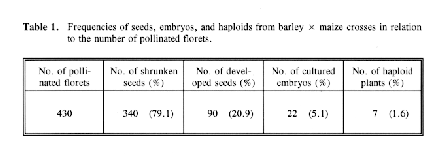

Wide crosses are promising means for haploid plant development through chromosome elimination during embryogenesis. Barley haploid plants have been obtained from barley × Hoardeum bulbosum (Kasha and Kao, 1970) and barley × rye (Secale cereale) (Fedak, 1977) crosses. Similarly, wheat haploid plants have been developed from wheat × H. bulbosum(Barcley, 1975) and wheat × maize (Comeau et al., 1988; Laurie and Bennett, 1988) crosses. In this report, we describe the development of barley haploids from barley × maize crosses.
Materials and Methods
The barley (Hordeum vulgare) cultivar "Aramir" was used as the female parent in crosses with maize (Zea mays) cultivar "Zenit". Barley and maize plants were maintained in a glasshouse (20°C ±2°C, 16 h light) throughout their growth.
Barley plants were emasculated two to three days before anthesis and covered with cellophane bags. Four to five days later, when the florets were completely open, spikes were pollinated with freshly collected maize pollen.
One day after pollination, the ears were sprayed with 75 ppm gibberellic acid (GA3). At the same time, about 0.5 ml of a 100 ppm 2,4-dichlorophenozyacetic acid (2,4-D) solution was injected into the uppermost internodes of the barley stem, as described by Laurie and Bennett (1988). All crosses were made during the spring.
After 15 to 20 days, the seeds were removed from the plants. Excised embryos were tranferred to tubes containing B5 basal medium supplemented wth 20 gL- 1 sucrose and 6 gL-1agar.
Cytological analysis of root tips of the regenerated plants was conducted, according to the standard Feulgen method.
Results and Discussion
A total of 430 barley plants were pollinated by maize pollen. A relatively high proportion (79.0%) of the pollinated florets developed into seeds (Table 1). This frequency of seed development was similar to that obtained when the same barley cultivar (Aramir) was used for haploid production in crosses with Hordeum bulbosum.
However, seeds obtained after maize pollination rarely developed embryos. Most of the seeds shrank and died within two weeks. Embryos were found and excised from only 22.4% of well-developed seeds. The rest of these seeds, in spite of their normal round shape, did not contain any visible embryos. The length of the dissected and cultured embryos ranged from 0.5 to 3.0 mm. On the culture medium, the majority of the embryos (68.2%) formed callus or developed into small, incomplete plants.
Only 7 out of 22 (31.8%) embryos cultured developed into green plants. Cytological analysis of the root tips of these plants confirmed their haploid chromosome number (n=7).
In spite of the low frequency of haploid plants obtained (1.6 per 100 florets pollinated), this work demonstrates that barley × maize crosses can lead to the formation of haploid embryos. This may be useful for barley haploid production.
The study will be continued to improve the efficiency of the proposed method of haploid barley production by choosing more effective genotypes of maize (Suenaga and Nakajima, 1989) and testing various applications of 2,4-D treatment (Riera and Mujeeb-Kazi, 1990).
Table 1. Frequencies of seeds, embryos, and haploids from barley × maize crosses in relation to the number of pollinated florets.

References
Barcley, I.R., 1975. High frequencies of haploid production in wheat (Triticum aestivum) by chromosome elimination. Nature 256:313-316.
Comeau, A., A. Plourde, C.A. St-Pierre, & P. Nadeau, 1988. Production of doubled haploid wheat lines by wheat × maize hybridization. Genome (Suppl. 1):482.
Fedak, G., 1977. Haploids from barley × rye crosses. Can. J. Genet. Cytol. 19:15-19.
Kasha, K.J. & K.N. Kao, 1970. High frequency of haploid production in barley (Hordeum vulgare L.). Nature 225:874-876.
Laurie, D.A. & M.D. Bennett, 1988. The production of haploid wheat plants from wheat × maize crosses. Theor. Appl. Genet. 76:393-397.
Riera-Lizarazu, 0. & A. Mujeeb-Kazi, 1990. Maize (Zea mays L.) mediated wheat (Triticum aestivum L.) polyhaploid production using various crossing methods. Cereal Research Communication 4:339-345.
Suenaga, K. & K. Nakajima, 1989. Efficient production of haploid wheat (Triticum aestivum) through crosses between wheat and maize (Zea mays). Plant Cell Rep. 8:263-266.